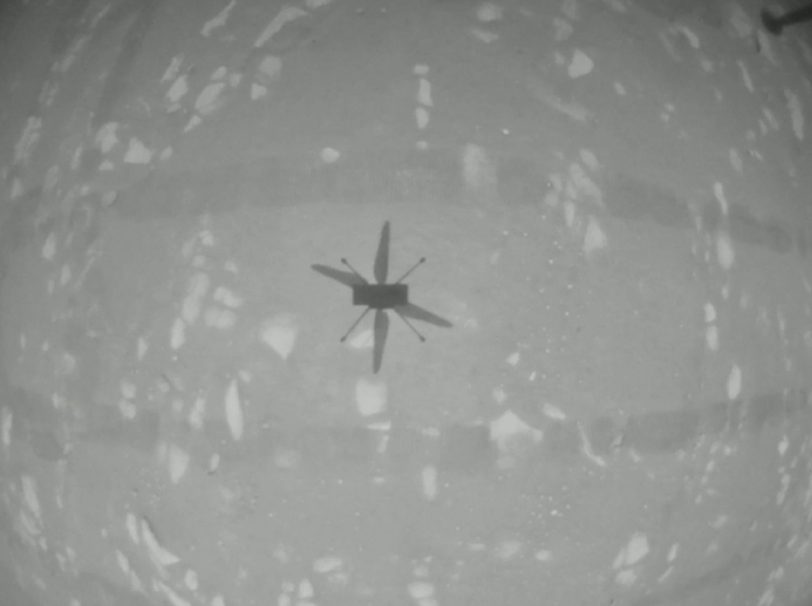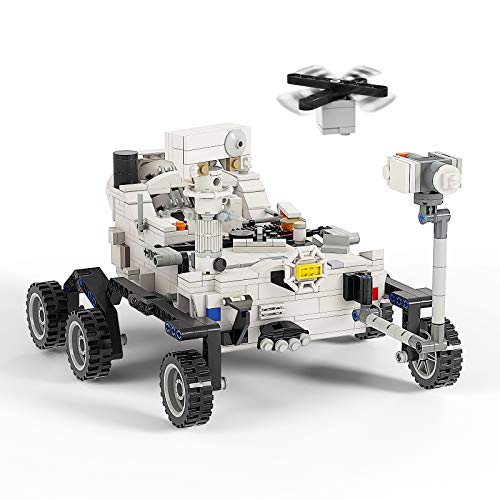Mars’ aerial exploration has begun.
NASA’s Ingenuity helicopter took off on Mars early this morning (April 19), making history as the first powered flight on a planet other than Earth.
The 4-pound (1.8 kilogram) chopper was set to lift off from the floor of Mars’ Jezero Crater at 12:31 a.m. EDT (0431 GMT) today, rise to a maximum height of 10 feet (3 meters), and land after roughly 40 seconds in the air.
At about 6:15 a.m. EDT (1015 GMT), data came down from Ingenuity — via its much larger partner, NASA’s Perseverance rover – that the little rotorcraft had hit its targets. The first photo from Ingenuity showed the shadow of the helicopter on the Martian surface below, while the Perseverance rover captured stunning video of the historic flight.
“Ingenuity has performed its first flight, the first flight of a powered aircraft on another planet!” Ingenuity’s chief pilot Havard Grip said as he confirmed telemetry at NASA’s Jet Propulsion Laboratory in Pasadena, California.
Even though today’s flight was brief, it could be game-changing, paving the way for future Martian aircraft exploration. Future Mars missions may use choppers as scouts for rovers or data collectors in their own right, thanks to Ingenuity’s groundbreaking work, NASA officials have said.
Pioneering Martian flight
Ingenuity’s $85 million mission is a technology demonstration, designed to show that powered, controlled flight is possible on the Red Planet. This was far from a given; the Martian atmosphere is just 1% as dense as that of Earth at sea level, so there’s not much air for helicopter blades to push against. This disadvantage outweighs the benefits that aircraft gain from Mars’ lower gravitational pull, which is just 38% as strong as Earth’s.
Ingenuity flew to Mars attached to the belly of Perseverance, landing inside Jezero with the $2.7 billion rover on Feb. 18. The solar-powered rotorcraft arrived on the crater floor earlier this month and started preparing for its historic month-long flight campaign, which was scheduled to start on April 11.
The flight attempt had been delayed from its original target date to give NASA time to update the machine’s software after a spin test of the rotors ended too early. An issue with the “watchdog” timer prevented the helicopter from spinning up correctly, but Ingenuity’s engineering team has corrected the problem. The solution, they said, allows for the chopper to “transition to flight mode and prepare for lift-off about 85% of the time.”
More to come
Ingenuity will fly again soon, if all goes according to plan — up to four more times, in fact, during its month-long window.
The helicopter will likely go slightly higher and farther on flights two and three, getting up to 16.5 feet (5 m) off the ground and moving a maximum of 165 feet (50 m) downrange, Aung said during a news conference earlier this month. If Ingenuity aces those next two flights, sorties four and five could be “really adventurous,” she added.

“History does tell us that soon after their first flight, Orville and Wilbur did go right back to work,” Aung said of the Wright brothers who performed the first heavier-than-air flight on Earth at Kitty Hawk, North Carolina on Dec. 17, 1903. They flew three more times that day, each one higher and farther than the last, Aung said.
With one successful flight under its belt, NASA’s Ingenuity team isn’t done. A series of increasingly difficult flights will be attempted in the coming weeks, pushing the limits of the tiny helicopter that could. It may not have covered quite the same distance as the Wright brothers, but Ingenuity has opened a path to achieve feats just as stunning elsewhere in the Cosmos.




